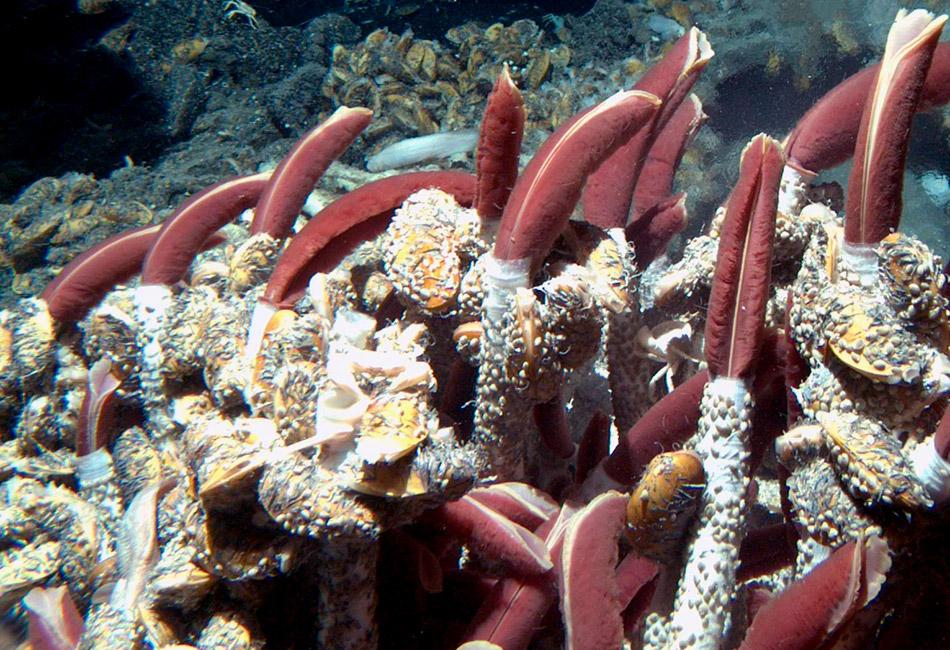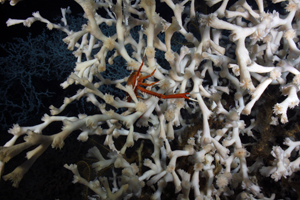Expedition 15:
Jan. 2 - 22, 2014
|
NEW Hot Topics!
Vent Ecosystems 
You Feed Me, I Feed You: Symbiosis Sampling ExtremesJanuary 14, 2014 (posted January 15, 2014) The deep ocean is a place of extremes. Water pressure there is more than 3,000 pounds per square inch, and temperatures hover near freezing. At vent sites, though, fluid coming up out of the seafloor can be incredibly hot. This past weekend, for example, the Jason team discovered a vent that reached more than 300˚ Celsius (572˚ Fahrenheit). Sampling and taking measurements in these environments require custom-built equipment that can stand up to the job, and some of the devices we’ve brought aboard are incredibly high-tech. They are made to withstand high heat and crushing pressure, while still sampling bits of fluid with pinpoint accuracy. When it comes to precision like this, it doesn't get much better than WHOI chemist Jeff Seewald’s Isobaric Gas-Tight samplers (IGTs). Each IGT is machined out of solid titanium and built so the thickness of its walls varies less than 1/20,000th of an inch. They’re as finely tuned as a race car’s engine and work just as smoothly. Avoiding decompressionAccording to Seewald, the device relies on that sort of exactness. Its sole purpose is to suck up vent fluids under the enormous pressures at the ocean floor and maintain that intense pressure within the instrument as it travels all the way to the surface. Without keeping the samples pressurized, the gases dissolved inside the fluid would escape as they came to the surface. "It would be almost like opening a can of soda," Seewald said. "As soon as the pressure is released, the gases would bubble out and disappear." Since Seewald wants to know exactly which chemicals and gases the fluids contain, that would be a big problem. To get around it, he and several engineers at WHOI designed the IGT, which he first tested in 1999. As vent water is pulled into the device, a titanium piston pushes down on it, keeping it pressurized. The piston doesn’t just compress the fluid, though. It also controls how fast fluid enters the sampler, which Seewald said is an incredibly important detail. "The pressure is so high in the deep ocean that if you just opened the valve on the IGT, the vent fluid or seawater would fill the device instantly." The piston would be slammed against the back of the sampler at nearly the speed of sound, which could damage the device itself. It would also mean he might not get a usable sample: If the cylinder fills that quickly, it could pull in mostly seawater instead of vent fluid. Tiny but critical chemistsKeeping the sample pressurized is also important for studying microbes at the vent site. On this cruise, graduate student Jesse McNichol and postdoctoral researcher François Thomas are using the IGTs as incubators, growing vent microbes inside them under the same pressure that exists at the vents. They will measure changes in the chemicals as the cells inside the devices use the chemicals. (You can learn more about their work in our dispatch from January 7). “This sort of high-pressure experiment is essential for looking at the activity of microbes from the vents, which is something we don’t currently know much about,” said WHOI microbiologist Stefan Sievert, who developed the experiments with McNichol and acts as his advisor back at WHOI. At the level of microbes, the line between chemistry and biology is thin, Seewald said. "These microbes depend on chemicals from the vents to survive, but as they grow, they also change the chemical content of the fluid. In fact, a lot of the chemistry that happens on Earth is controlled by microbes. So to really understand the chemistry of the oceans, you also need to understand the actions of the microbes living there." On this cruise, the researchers said, the IGT is proving to be a powerful tool for studying both.
[ Previous update ] [ Next update ]
|
Mailing List | Feedback | Glossary | For Teachers | About Us | Contact
© 2013 Dive and Discover™. Dive and Discover™ is a registered trademark of Woods
Hole Oceanographic Institution



